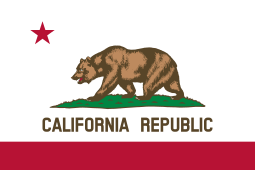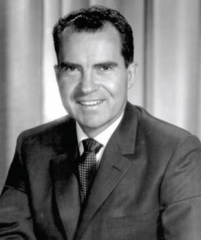California gubernatorial election, 1962
California gubernatorial election, 1962

|
|
|
|
|

|
| Election results by county |
|
|
The California gubernatorial election, 1962 was held on November 6, 1962. The Democratic incumbent, Pat Brown, ran for re-election against former Vice President Richard Nixon. In his concession speech, Nixon accused the media of favoring his opponent Brown, stating that it was his "last press conference" and "You won't have Dick Nixon to kick around any more."[1] Six years later, Nixon was elected President of the United States.
Election background
Edmund G. (Pat) Brown Sr. was a relatively popular Democratic governor in California who was first elected in 1958.[2] At the time, California was generally considered a Republican stronghold, with Republican governors and senators from the end of World War II until the election of Democrat Clair Engle to the Senate in 1958, and Brown's election as governor the same year. The state voted for Eisenhower in 1952 and 1956, and Nixon carried the state over John F. Kennedy in the 1960 Presidential election.
In 1962, with popular incumbent Senator Thomas Kuchel a shoo-in for re-election, the Republican Party felt it could also gain the governorship and win the state back from the Democrats. They turned to former Vice President Richard Nixon, the biggest name at the time in the California Republican Party. Having been elected Senator in 1950 and carrying the state against Kennedy in 1960, they also felt a convincing win could be a springboard for Nixon to challenge Kennedy again in 1964, since he narrowly lost to him in 1960.[3] However, the conservative Joe Shell challenged Nixon in the primary, and received support from the John Birch Society. Although Nixon beat Shell in the primary, 1,285,151 votes (65.4 percent) to Shell's 656,542 (33.4 percent), the contest was bitter, and Nixon did not reach out to conservative Shell supporters, which weakened him in the general election.[4]
In a bitter and expensive campaign, Brown and Nixon campaigned with great zeal and effort. Nixon had a lead in the polls early on, but Brown chipped away at his lead. Still, come election day, Nixon was favored to win a relatively close election. But Brown not only won, but by a surprising 5%. A stunned and frustrated Nixon announced he was retiring from politics.
General election results
Results by county
| County |
Brown |
Votes |
Nixon |
Votes |
Wyckoff |
Votes |
| Plumas |
66.44% |
3,397 |
31.76% |
1,624 |
1.80% |
92 |
| Trinity |
64.58% |
2,201 |
33.69% |
1,148 |
1.73% |
59 |
| Solano |
64.31% |
25,987 |
34.37% |
13,888 |
1.32% |
532 |
| Shasta |
63.97% |
14,753 |
34.07% |
7,858 |
1.96% |
453 |
| Lassen |
62.50% |
3,500 |
35.14% |
1,968 |
2.36% |
132 |
| San Francisco |
62.19% |
180,298 |
36.96% |
107,165 |
0.85% |
2,455 |
| Sacramento |
60.69% |
115,462 |
37.74% |
71,788 |
1.57% |
2,988 |
| Yolo |
60.67% |
13,334 |
37.82% |
8,311 |
1.51% |
332 |
| Madera |
60.46% |
7,728 |
38.36% |
4,903 |
1.19% |
152 |
| Placer |
59.98% |
13,592 |
38.29% |
8,677 |
1.72% |
390 |
| Siskiyou |
59.98% |
7,718 |
38.41% |
4,942 |
1.62% |
208 |
| Kings |
59.03% |
9,141 |
39.48% |
6,113 |
1.49% |
231 |
| Amador |
58.16% |
2,811 |
40.16% |
1,941 |
1.68% |
81 |
| Alameda |
57.98% |
206,861 |
40.88% |
145,851 |
1.13% |
4,038 |
| Sierra |
57.98% |
676 |
39.54% |
461 |
2.49% |
29 |
| Fresno |
57.78% |
68,187 |
40.85% |
48,211 |
1.37% |
1,615 |
| Merced |
57.62% |
14,105 |
41.14% |
10,071 |
1.23% |
302 |
| El Dorado |
56.25% |
6,572 |
41.44% |
4,842 |
2.30% |
269 |
| Contra Costa |
55.49% |
91,150 |
43.34% |
71,192 |
1.18% |
1,935 |
| Yuba |
53.77% |
5,028 |
44.74% |
4,184 |
1.49% |
139 |
| Stanislaus |
53.64% |
30,431 |
44.80% |
25,417 |
1.57% |
888 |
| Napa |
53.50% |
14,748 |
44.72% |
12,326 |
1.78% |
490 |
| Ventura |
53.46% |
37,777 |
45.15% |
31,899 |
1.39% |
982 |
| San Luis Obispo |
52.86% |
16,110 |
45.36% |
13,825 |
1.78% |
543 |
| Tuolumne |
52.48% |
3,631 |
46.06% |
3,187 |
1.46% |
101 |
| Humboldt |
52.19% |
17,739 |
46.22% |
15,708 |
1.59% |
540 |
| Kern |
52.10% |
48,737 |
46.33% |
43,342 |
1.57% |
1,471 |
| Colusa |
52.06% |
2,320 |
46.14% |
2,056 |
1.80% |
80 |
| Del Norte |
51.97% |
2,741 |
45.85% |
2,418 |
2.18% |
115 |
| San Mateo |
51.88% |
90,464 |
47.09% |
82,115 |
1.03% |
1,797 |
| Los Angeles |
51.83% |
1,191,724 |
46.98% |
1,080,113 |
1.19% |
27,445 |
| Modoc |
51.73% |
1,641 |
46.44% |
1,473 |
1.83% |
58 |
| San Bernardino |
51.68% |
88,437 |
46.78% |
80,054 |
1.54% |
2,634 |
| Mendocino |
51.50% |
8,704 |
46.96% |
7,936 |
1.54% |
261 |
| Tehama |
51.36% |
5,077 |
46.44% |
4,591 |
2.21% |
218 |
| Santa Clara |
51.20% |
121,149 |
47.63% |
112,700 |
1.18% |
2,783 |
| Nevada |
51.02% |
4,818 |
47.12% |
4,450 |
1.85% |
175 |
| San Joaquin |
49.40% |
43,276 |
49.25% |
43,147 |
1.34% |
1,178 |
| Sonoma |
49.19% |
29,373 |
49.65% |
29,647 |
1.17% |
696 |
| Tulare |
49.08% |
24,598 |
49.71% |
24,914 |
1.21% |
608 |
| Glenn |
48.70% |
3,299 |
49.50% |
3,353 |
1.80% |
122 |
| San Benito |
48.30% |
2,527 |
50.46% |
2,640 |
1.24% |
65 |
| Butte |
47.74% |
16,142 |
50.79% |
17,172 |
1.47% |
497 |
| Mariposa |
47.50% |
1,272 |
50.37% |
1,349 |
2.13% |
57 |
| Santa Barbara |
47.50% |
30,424 |
51.24% |
32,821 |
1.26% |
807 |
| Inyo |
47.00% |
2,526 |
50.99% |
2,740 |
2.01% |
108 |
| Riverside |
46.60% |
50,257 |
51.86% |
55,926 |
1.54% |
1,666 |
| Monterey |
46.52% |
24,801 |
52.52% |
28,000 |
0.96% |
512 |
| Calaveras |
46.37% |
2,379 |
51.75% |
2,655 |
1.87% |
96 |
| Marin |
45.38% |
27,664 |
53.67% |
32,720 |
0.95% |
582 |
| Santa Cruz |
44.93% |
17,354 |
53.28% |
20,580 |
1.79% |
690 |
| Lake |
44.42% |
3,315 |
54.15% |
4,041 |
1.43% |
107 |
| Imperial |
44.14% |
8,241 |
55.01% |
10,271 |
0.85% |
158 |
| San Diego |
42.40% |
153,389 |
55.83% |
201,969 |
1.77% |
6,416 |
| Sutter |
41.19% |
4,816 |
57.59% |
6,734 |
1.21% |
142 |
| Orange |
39.16% |
112,152 |
59.35% |
169,962 |
1.49% |
4,263 |
| Mono |
36.12% |
488 |
62.18% |
840 |
1.70% |
23 |
| Alpine |
34.72% |
67 |
63.21% |
122 |
2.07% |
4 |
References
- ↑ Matthews, Christopher J (1997). Kennedy and Nixon: The Rivalry That Shaped Postwar America. Free Press. pp. 215–218. ISBN 978-0-684-83246-3.
- ↑ Lawrence, David G (2009). California: The Politics of Diversity. Wadsworth Publishing. p. 35. ISBN 978-0-495-57097-4.
- ↑ Starr, Kevin (2009). Golden Dreams: California in an Age of Abundance, 1950-1963. Oxford University Press. pp. 215–216. ISBN 978-0-19-515377-4.
- ↑ Perlstein, Rick (2002). Before the Storm: Barry Goldwater and the Unmaking of the American Consensus.



